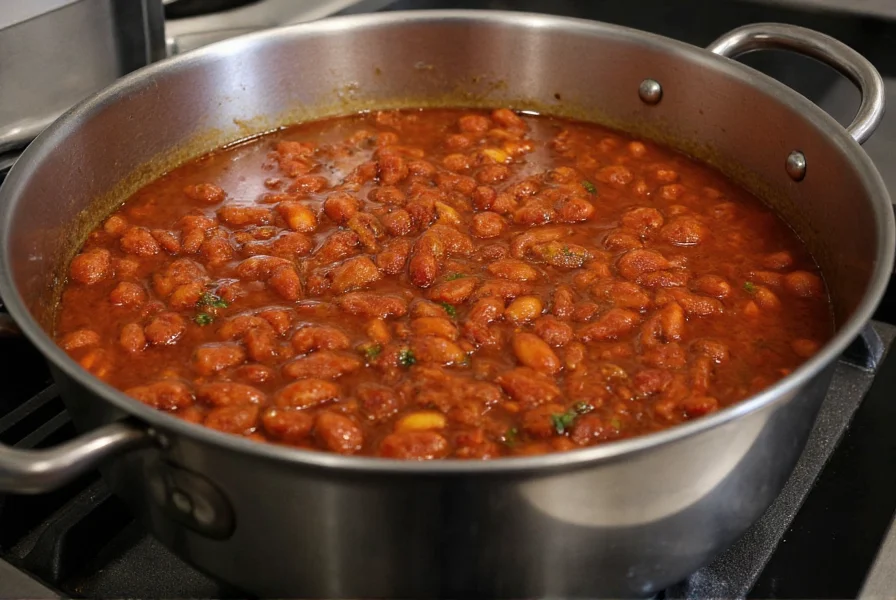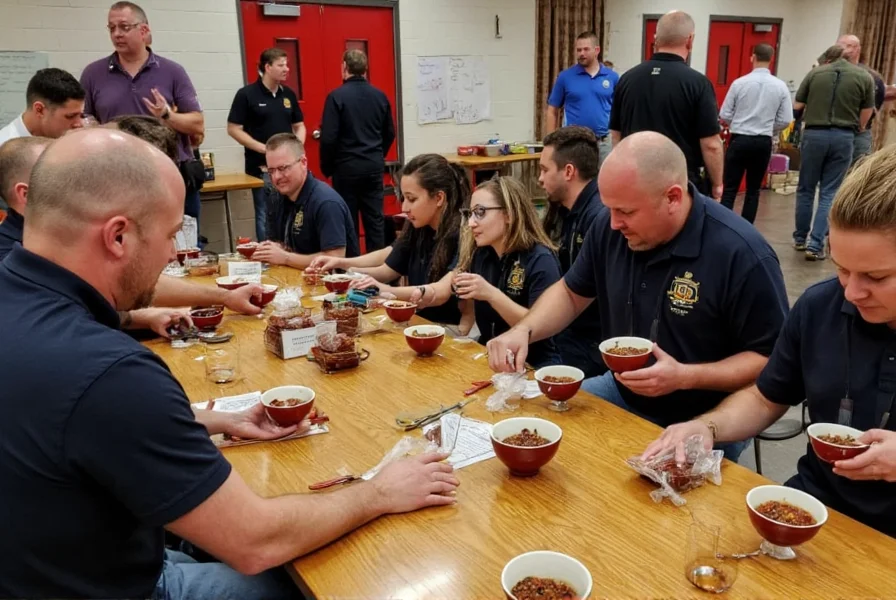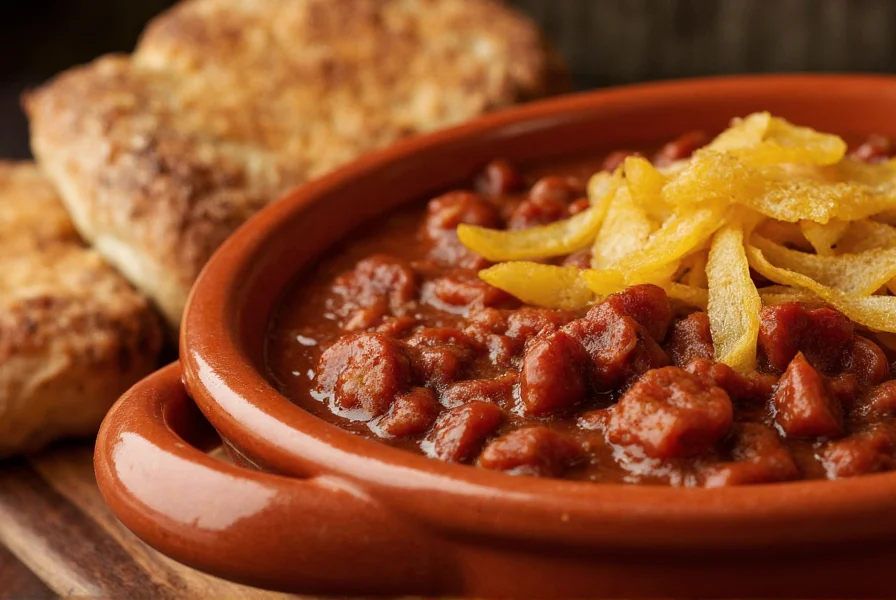
The Origins of Firehouse Chili Tradition
Firehouse chili emerged from practical necessity in early 20th century fire stations. Before modern firehouse kitchens, firefighters needed affordable, one-pot meals they could prepare themselves during long shifts. The dish evolved from Texas chili traditions but adapted to feed 10-20 people at a time. Unlike restaurant chili, firehouse versions prioritize economy, simplicity, and consistent results when made by rotating crew members with varying cooking skills.
What Makes Firehouse Chili Different From Regular Chili
Authentic firehouse chili differs from standard recipes in several key ways:
| Feature | Firehouse Chili | Regular Chili |
|---|---|---|
| Batch Size | Feeds 10-20 people | Serves 4-6 people |
| Ingredients | Basic, affordable staples | Premium or specialty items |
| Cooking Time | 4+ hours for shift coverage | 1-2 hours typical |
| Recipe Consistency | Standardized station-wide | Variety of personal versions |
Firehouse chili recipes remain remarkably consistent across departments because they're designed for reliability. Firefighters often inherit recipes passed down through generations of crew members, with each station developing slight variations while maintaining core principles. The "firehouse chili recipe for large groups" must work whether cooked by a culinary expert or someone with minimal kitchen experience.
Authentic Firehouse Chili Recipe
This traditional firehouse chili recipe serves 15-20 people and follows the "how to make firehouse chili for a crowd" principles used in actual fire stations:
Ingredients
- 5 pounds ground beef (80% lean)
- 2 large onions, diced
- 1 cup chili powder
- 2 tablespoons cumin
- 1 tablespoon garlic powder
- 6 (15-ounce) cans kidney beans, drained
- 4 (28-ounce) cans crushed tomatoes
- 2 cups beef broth
- 1 cup tomato paste
- Salt and black pepper to taste
Preparation
- Brown ground beef and onions in a 20-quart stock pot
- Drain excess fat but retain some for flavor
- Add chili powder, cumin, and garlic powder; cook 2 minutes
- Stir in tomatoes, tomato paste, and beef broth
- Add kidney beans and bring to gentle simmer
- Cover and cook on low heat for 4-6 hours
- Stir occasionally and adjust seasoning as needed

Firehouse Chili Cooking Techniques
Professional firehouse chili preparation follows specific techniques that ensure consistent results. The "firehouse chili cooking method" emphasizes low-and-slow simmering, which develops complex flavors while accommodating irregular cooking schedules during emergency responses. Many stations use industrial steam-jacketed kettles that maintain consistent temperature even when unattended.
Unlike home recipes, authentic firehouse chili rarely includes exotic ingredients. The "traditional firehouse chili ingredients list" focuses on shelf-stable items that remain available despite unpredictable shift changes. Most fire stations maintain a standardized spice ratio that crew members follow precisely, ensuring the chili tastes the same regardless of who prepares it.
Serving Traditions and Community Impact
Firehouse chili serves both practical and cultural purposes within fire departments. Beyond providing sustenance during 24-hour shifts, it functions as a team-building activity where new members learn station traditions. Many fire departments open their doors to the public during emergencies, and chili often becomes a symbol of community connection.
The "firehouse chili community tradition" extends beyond station walls. Numerous departments host annual chili cook-offs that raise funds for local charities. These events preserve the culinary heritage while strengthening town-gown relationships. Some fire stations even maintain "chili logs" documenting recipe variations and memorable cooking incidents throughout the department's history.
Adapting Firehouse Chili for Home Kitchens
Home cooks can successfully recreate authentic firehouse chili by following these adaptation tips:
- Scale down the "firehouse chili recipe for large groups" proportionally
- Maintain the same ingredient ratios for authentic flavor profile
- Simmer for at least 2 hours to develop proper depth of flavor
- Use a heavy-bottomed pot to prevent scorching during long cooking
- Store leftovers properly as firehouse chili tastes better the next day
While home versions won't match the industrial scale of actual firehouse preparations, maintaining the spirit of simplicity and heartiness captures the essence of this culinary tradition. The "how to make firehouse chili at home" process connects modern cooks with decades of firefighter camaraderie.
What is the difference between firehouse chili and regular chili?
Firehouse chili differs primarily in scale and consistency. It's designed to feed 10-20 people using standardized recipes that produce reliable results regardless of who cooks it. Firehouse versions prioritize affordable, shelf-stable ingredients and longer cooking times to accommodate 24-hour shifts, while regular chili recipes often feature specialty ingredients and serve smaller groups.
Why do firefighters make chili instead of other meals?
Firefighters make chili because it's practical for their work environment. The one-pot meal can simmer unattended during emergency responses, feeds varying numbers of crew members, uses affordable ingredients, and tastes better after multiple reheating cycles. Its long cooking time aligns with 24-hour shifts, and the standardized recipe ensures consistent results regardless of which crew member prepares it.
Can you make authentic firehouse chili in a regular home kitchen?
Yes, you can adapt firehouse chili for home cooking by maintaining the same ingredient ratios while scaling down quantities. Use a heavy-bottomed pot for even heating, simmer for at least 2 hours, and follow the simple ingredient list without gourmet additions. The key is preserving the hearty, no-frills character rather than exact batch size. Authentic firehouse chili flavor comes from proper spice ratios and long simmering, not special equipment.
What are the essential spices in traditional firehouse chili?
Traditional firehouse chili relies on three essential spices: chili powder (the primary flavor), cumin (for earthy depth), and garlic powder (for savory notes). These create the distinctive flavor profile without requiring fresh ingredients that might spoil between cooking sessions. Most fire stations maintain strict ratios of these core spices to ensure consistency regardless of who prepares the batch.
How long does authentic firehouse chili need to simmer?
Authentic firehouse chili simmers for 4-6 hours in fire stations. This extended cooking time develops complex flavors, tenderizes the meat properly, and accommodates the unpredictable nature of firefighting where crew members might need to leave the kitchen suddenly for emergency responses. For home cooking, a minimum 2-hour simmer captures the essential flavor development while being practical for most schedules.











 浙公网安备
33010002000092号
浙公网安备
33010002000092号 浙B2-20120091-4
浙B2-20120091-4